Ahsan A. Two Phase Flow, Phase Change and Numerical Modeling
Подождите немного. Документ загружается.

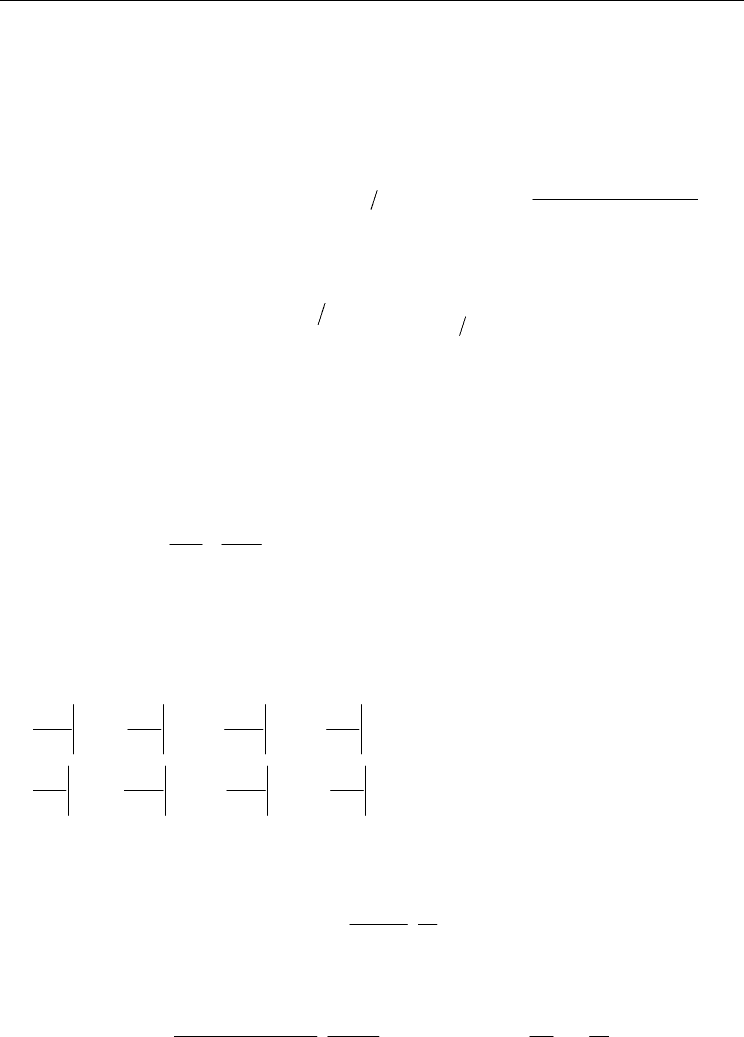
New Variants to Theoretical Investigations of Thermosyphon Loop
369
The flow in natural circulation systems which is driven by density distribution is also
known as a gravity driven flow or thermosyphonic flow. The momentum and the energy
equations in such flows are coupled and for this reason they must be solved simultaneously
(Mikielewicz, 1995).
The above governing equations can be transformed to their dimensionless forms by the
following scaling:
2
0H0
000
2
H
(A /U ) (T T )
(a )/L ; s s /L ; m (m L) (a A) ; T ;
(q L )
+++ +
λ⋅ ⋅ −
τ= ⋅τ = = ⋅ ⋅ρ⋅ =
⋅
(4)
The dimensionless momentum equation and the energy equation at the steady state for the
thermosyphon loop heated from below can be written as follows:
-
momentum equation (with:
jj
KsL;= ) and
1forlaminarflow
7 4 for turbulent flow
θ=
;
()
()
()
1
**
0
m(Ra)1Tcose,
g
ds ;
θ
+++
=−⋅⋅
(5)
-
energy equation
2
**
2
0insulatedsections
dT d T
m (Bi) T for coolin
g
section
ds ds
1 heater section
++
++
++
+
=−⋅
+
(6)
with boundary conditions
22 3 3
55
A1 2 H 2 A1 3 C 3 C 5 A2 5 A2 H
A1 H A1 C
sK sK sK sK
CA2 A2 H
sK sK s1 s0
T ( K ) T ( K ) ; T (K ) T (K ) ; T (K ) T (K ) ; T (1) T (0) ;
dT dT dT dT
;;
ds ds ds ds
dT dT dT dT
;;
ds ds ds ds
++ + +
++ ++
++ ++ ++ ++
++ + +
++ + +
== = =
++ + +
++ + +
== ==
====
==
==
(7)
The parameters appearing in the momentum and the energy equations are the modified
Biot, Rayleigh and Prandtl numbers.
2
**
CC
0
UL
(Bi) ;
A
α⋅
=⋅
λ
(8)
for laminar flow:
()
1θ=
2
3
** ** 2
0H0
H0
ll
2
00 0
gL(q/)
AU U
(Ra) ; (Pr) 2 L ;
a2U Aa
⋅β ⋅ ⋅ λ
⋅ν
=⋅=⋅⋅⋅
ν⋅ ⋅
(9)
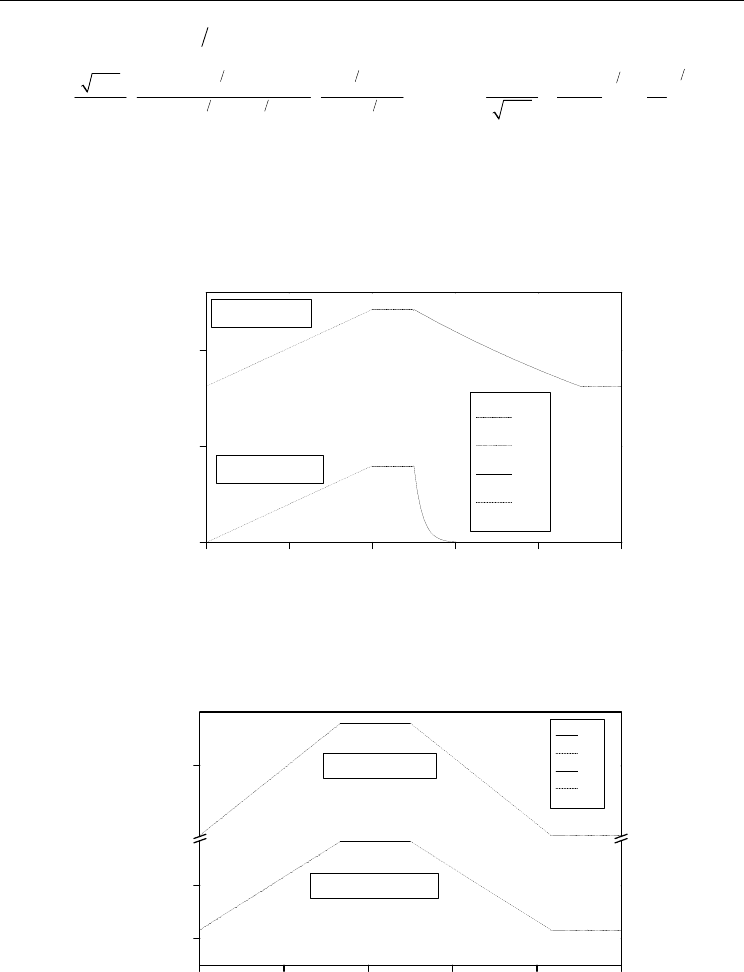
Two Phase Flow, Phase Change and Numerical Modeling
370
for turbulent flow:
()
74θ=
()
() ()
()
()
14
15 4 1 4
54
0H0 H
** **
0
t t
14 74 54
0
00
gL(q/)AU
128 0.3164 L U
(Ra) ; (Pr) ;
0.3164 A a
128
aU
⋅
β
⋅⋅λ ⋅
⋅ν
=⋅ ⋅ =⋅ ⋅
ν⋅
(10)
In the case of the laminar and turbulent steady-state flow, the dimensionless distributions of
temperature around the loop can be obtained analytically from Eq. (6). The distilled water
was used as the working fluid.
It has been found that the Biot number has an influence on temperature in the laminar and
turbulent flow. The results are shown in Figs. 2 and 3.
0,0 0,2 0,4 0,6 0,8 1,0
00
5x10
-5
5x10
-5
1x10
-4
1x10
-4
T
+
A1
T
+
A2
T
+
C
T
+
H
(Bi)
**
= 5*10
5
(Bi)
**
=1*10
4
DIMENSIONLESS TEMPERATURE T
+
DIMENSIONLESS COORDINATE s
+
Fig. 2. The effect of Biot number on temperatures in the laminar steady-state flow
(HHVCHV)
0,00,20,40,60,81,0
1,98x10
-6
2,00x10
-6
1,00x10
-4
T
+
A1
T
+
A2
T
+
C
T
+
H
(Bi)
**
= 5*10
5
(Bi)
**
=1*10
4
DIMENSIONLESS TEMPERATURE T
+
DIMENSIONLESS COORDINATE s
+
Fig. 3. The effect of Biot number on temperatures in the turbulent steady-state flow
(HHVCHV)
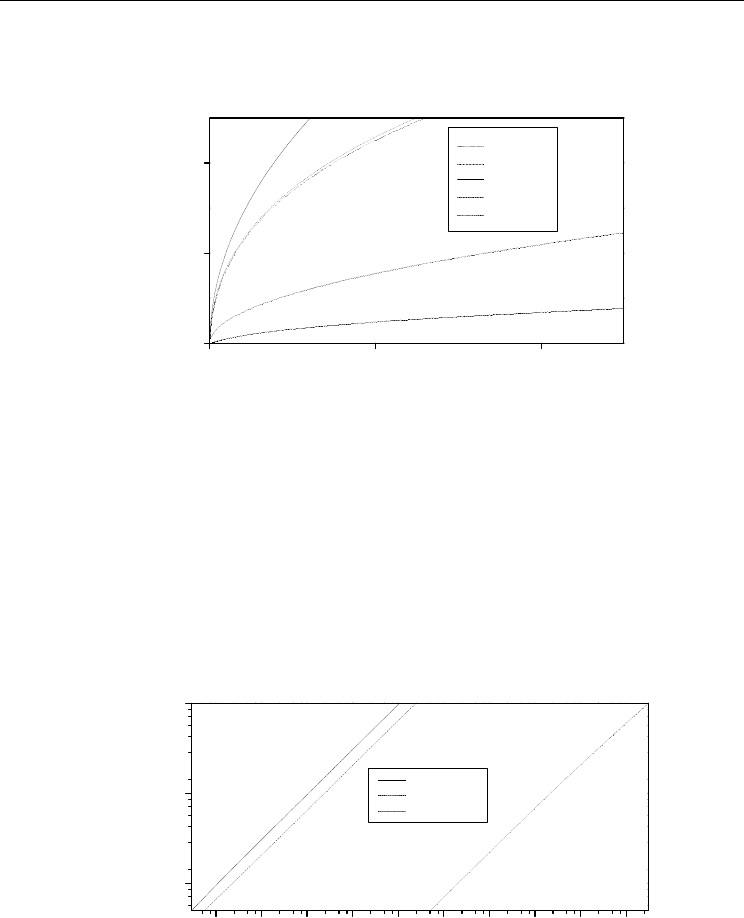
New Variants to Theoretical Investigations of Thermosyphon Loop
371
The effect of the loop’s aspect ratio (breadth B to height H) on the mass flow rate found
numerically in the case of laminar flow at the steady state is presented in Fig. 4 .
0
4x10
9
8x10
9
0
4x10
3
8x10
3
B/H = 1*10
-3
B/H = 1*10
-2
B/H = 1,1
B/H = 1*10
2
B/H = 1*10
3
MASS FLOW RATE m
l
+
MODIFIED RAYLEIGH NUMBER (Ra)
l
**
Fig. 4. Mass flow rate for laminar flow at the steady state versus modified Rayleigh number
at different B/H ratios (HHVCHV)
For this variant of the thermosyphon loop it has been found that the maximum of the mass
flow rate appears for B/H=1,1 .
The effect of geometrical parameter of the loop (length of insulation section G to height H)
on the mass flow rate found numerically in the case of laminar flow at the steady state is
presented in Fig. 5. The mass flow rate increases with decreasing
G/H aspect ratio, due to the
decreasing frictional pressure term.
1x10
6
1x10
8
1x10
10
1x10
12
1x10
14
1x10
2
1x10
3
1x10
4
G/H = 0,001
G/H = 1
G/H = 1000
MASS FLOW RATE m
l
+
MODIFIED RAYLEIGH NUMBER (Ra)
l
**
Fig. 5. Mass flow rate for laminar flow at the steady state versus modified Rayleigh number
at different G/H ratios (HHVCHV)
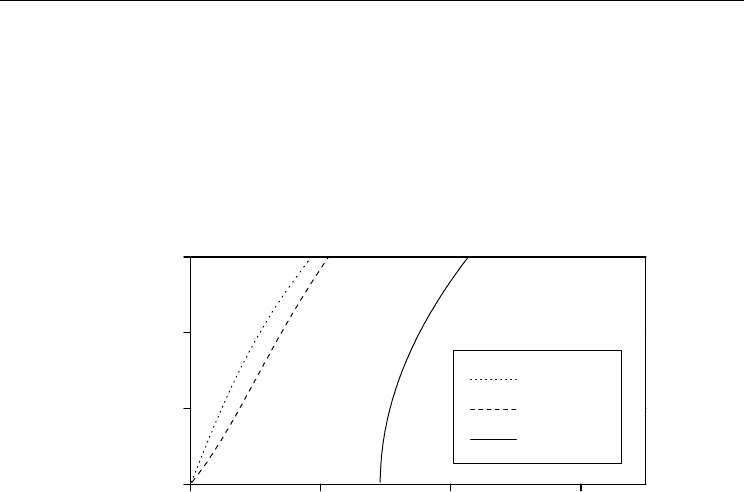
Two Phase Flow, Phase Change and Numerical Modeling
372
This paper presents the case of the onset of motion of the single-phase fluid from a rest state
if the loop rotates 90 degrees around the x-axis. The heated sections can be presented in the
horizontal plane below the cooled sections. The presented numerical calculations are based
on a new method for solution of the problem for the onset of motion in the fluid from the
rest (Bieliński & Mikielewicz, 2005). Conditions for the onset of motion in the thermosyphon
can be determined by considering the steady solutions with circulation for the limiting case
of
l
m0
+
→
.
0
1x10
3
2x10
3
3x10
3
00
22
44
66
ψ = 0
o
ψ = 60
o
ψ = 90
o
MASS FLOW RATE m
l
+
MODIFIED RAYLEIGH NUMBER (Ra)
l
**
Fig. 6. The case of the onset of motion of the single-phase fluid from a rest state if the loop
rotates 90 degrees around the x-axis (HHVCHV+
o
90ψ )
The analysis was based on the equations of motion and energy for the steady-state
conditions. The heat conduction term has to be taken into account in this approach because
the heat transfer due to conduction is becoming an increasingly important factor for
decreasing mass flow rates. The fluid starts circulation around the loop, when the Rayleigh
number exceeds a critical value, which can be found using the method
l
m0
+
→
for the
o
90ψ= angle. The critical Rayleigh number for angles
o
90ψ< is zero. This means that the
circulation of the fluid around the loop begins after the start up of the heating (Fig. 6).
3. Two-phase thermosyphon loop with heated from lower horizontal and
vertical parts and cooled from upper horizontal and vertical parts
The variant of the two-phase closed thermosyphon loop consists of two heaters and two
coolers connected by channels. A schematic diagram of a one-dimensional model of the
thermosyphon loop is shown in Fig. 7. The thermosyphon loop is heated from lower
horizontal section
01
(s s s )≤≤ and lower vertical section
34
(s s s )≤≤ by a constant heat flux:
H1
q
and
H2
q
, respectively and cooled in the upper horizontal section
67
(s s s )≤≤ and
upper vertical section
910
(s s s )≤≤ by a constant heat flux:
C1
q
and
C2
q
, respectively.
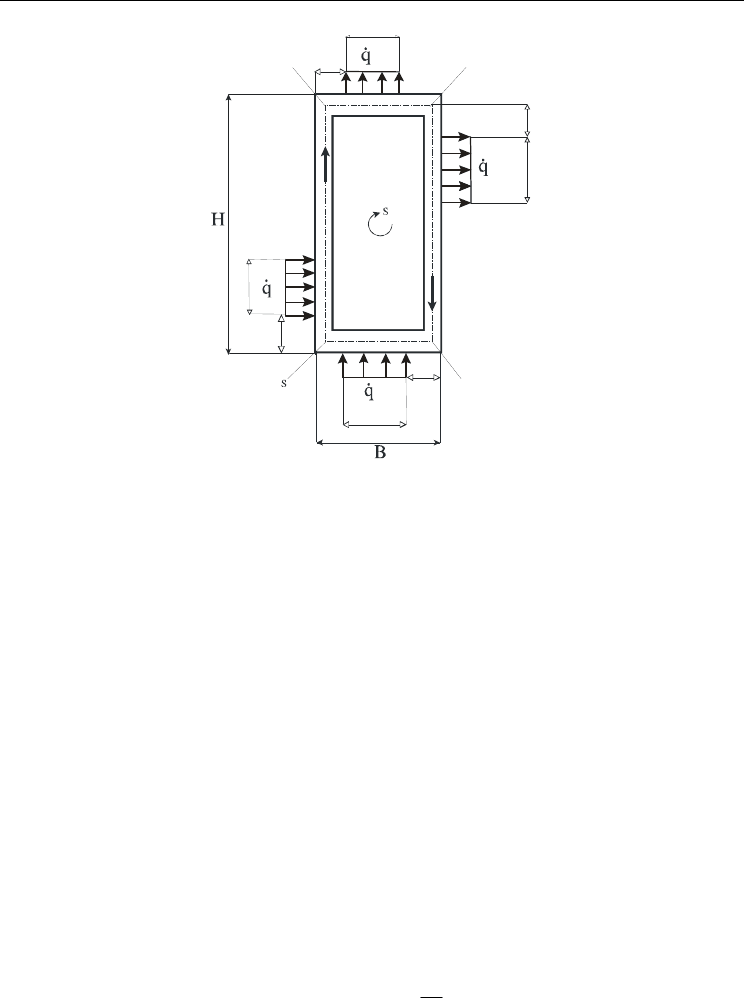
New Variants to Theoretical Investigations of Thermosyphon Loop
373
4
C2
C1
L
L
C2
H2
6
5
1
7
2
3
L
L
L
L
L
8
10
0
9
11
12
H1
H2
S
S
S
S
S
S
S
S
S
SS
S
0H2
0H1
H1
0C1
C1
0C2
L
Fig. 7. A schematic diagram of a one-dimensional model of the thermosyphon loop (2H2C)
The constant heat fluxes
H1
q
,
H2
q
and
C1
q
,
C2
q
are applied in the cross-section area per
heated and cooled length:
H1
L
,
H2
L
and
C1
L
,
C2
L
,respectively. The heated and cooled parts
of the thermosyphon loop are connected by perfectly insulated channels
13
(s s s )≤≤
,
46
(s s s )≤≤
,
79
(s s s )≤≤
,
10 12
(s s s )≤≤
.
The coordinate s along the loop and the characteristic geometrical points on the loop are
marked with s
j
, as shown in Fig. 7. The total length of the loop is denoted by L, the cross-
section area of the channel by
A and the wetted perimeter by U . Thermal properties of
fluid:
ρ
- density,
p
c - heat capacity of constant pressure, λ - thermal conductivity.
The following additional assumptions are made in this study:
1.
heat exchangers in the thermosyphon loop can be equipped by minichannels,
2.
two-phase fluid can be selected as the working fluid,
3.
friction coefficient is constant in each region of the loop, separate two-phase flow model
can be used in calculations for the frictional pressure loss in the heated, cooled and
adiabatic two-phase sections; the two-phase friction factor multiplier
2
L0
R =φ is used;
the density in the gravity term can be approximated as follows:
()
VL
1
ρ
=α⋅
ρ
+−α⋅
ρ
,
where α is a void fraction,
4.
quality of vapour in the two-phase regions is assumed to be a linear function of the
coordinate around the loop,
5.
effect of superheating and subcooling are neglected.
In order to eliminate the pressure gradient and the acceleration term, the momentum
equation in Eq. (2) is integrated around the loop
p
ds 0
s
∂
=
∂
.
After integrating the gravitational term in the momentum equation (2) around the loop, we
obtain
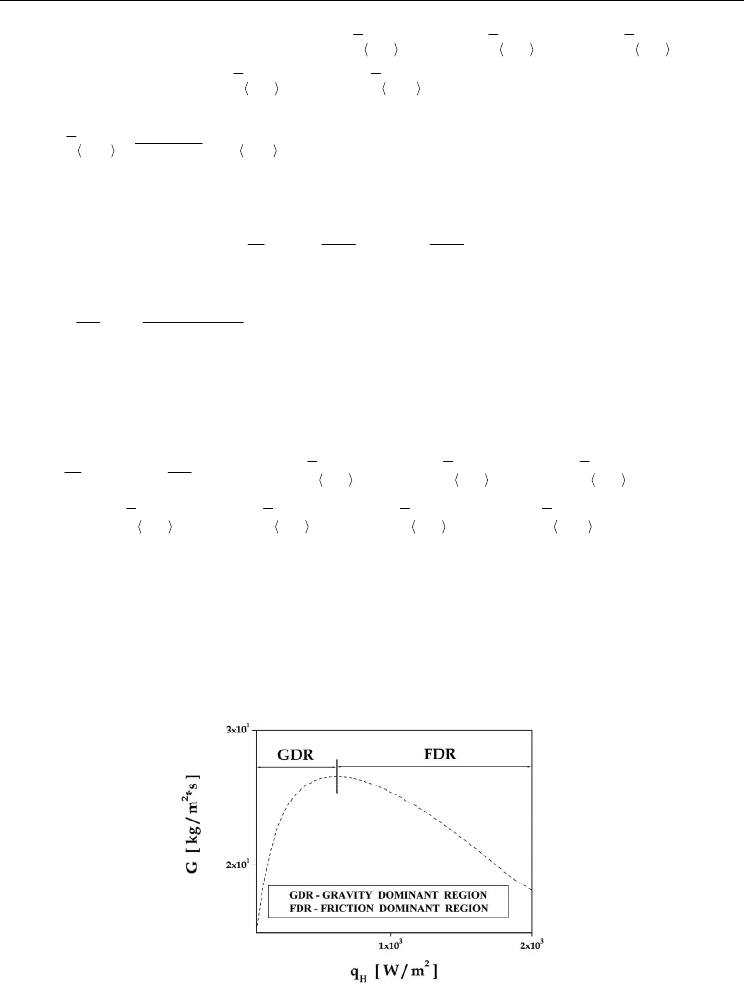
Two Phase Flow, Phase Change and Numerical Modeling
374
{}
()() () ()
{
() ()
}
13 34 46
79 910
VL 32 43 54
s;s s;s s;s
98 109
s;s s;s
g dsg ss ss ss
ss s s 0;
ε⋅ ⋅
ρ
=⋅
ρ
−
ρ
⋅ − ⋅α + − ⋅α + − ⋅α +
− − ⋅α − − ⋅α =
(11)
where
()
()
K
PK PK
P
s
s;s s;s
KP
s
1
sds
ss
α= ⋅α
−
.
Due to the friction of fluid, the pressure losses in two-phase regions can be calculated as
w
2p L0
Udp dp
R
Ads ds
−−
⋅τ = = ⋅
(12)
where:
()
2
Chur
L0
L0
L
2f G
dp
ds D
⋅⋅
=
⋅ρ
is the liquid only frictional pressure gradient calculated for
the total liquid mass velocity,
Gw=
ρ
⋅
,
Chur
L0
f
is friction factor of the fluid (Churchill, 1977).
After integrating the friction term in Eq. (2) around the loop, the solution is obtained as
follows
() () ()
{
() () () () ()
}
01 13 34
46 67 79 910
w103143
s;s s;s s;s
L0
64 76 97 109 1210
s;s s;s s;s s;s
Udp
ds ssR ssR ssR
Ads
ssR ssR ssR s sR s s ;
⋅τ = ⋅ −⋅ +−⋅ +−⋅ +
+−⋅ +−⋅ +−⋅ + −⋅ + −
(13)
3.1 Minichannels. Distribution of the mass flux
The following correlations have been used in calculation of the thermosyphon loop with
minichannels (Table 1): the El-Hajal correlation for void fraction (El-Hajal et al., 2003), the
Zhang-Webb correlation for the friction pressure drop of two-phase flow in adiabatic region
(Zhang & Webb, 2001), the Tran correlation for the friction pressure drop of two-phase flow
in diabatic region (Tran et al. 2000).
Fig. 8. Minichannels. Mass flux
G
as a function of
H
q
for the steady state (2H2C), (L=0.2
[m], D=0.002 [m], H=0.07 [m], B=0.03 [m], L
H1
= L
H2
=L
C1
= L
C2
=0.02 [m],
L
H1P
= L
H2P
=L
C1P
= L
C2P
=0.005 [m] )
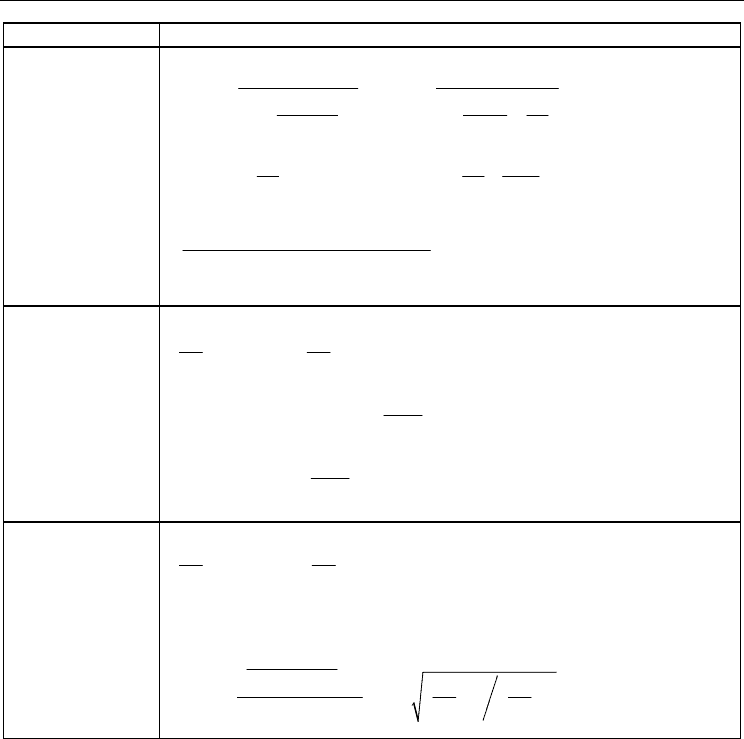
New Variants to Theoretical Investigations of Thermosyphon Loop
375
Researcher Correlation
El-Hajal et al.,
(2003)
HOM STEINER
HAJAL HOM
V
HOM
L
STEINER
1
;;
1x
1
ln
x
α−α
α= α=
−ρ
α
+⋅
ρ
α
()
() ( )
()
0.25
STEINER
VVL
(1)
LV
0.5
L
xx1x
10.121x
1.18 1 x g
;
G
−
−
α=× +⋅− ⋅+ +
ρρρ
⋅−⋅ ⋅σ⋅ ρ −ρ
+
⋅ρ
(14)
Zhang & Webb,
(2001)
() ()
()
()
()
ZW
2
L0
2p L0
1
22
2
L0
CRIT
1.64
0.25
CRIT
dp dp
;
dl dz
P
1 x 2.87 x
P
P
1.68 1 x ;
P
−
−
−
=Φ ⋅
Φ= − + ⋅ ⋅ +
+⋅− ⋅
(15)
Tran
et al., (2000)
()
() ( ) ()
()
TRAN
2
L0
2p L0
0.875 0.875 1.75
22
L0 CONF
0.5
LV
CONF
V0 L0
dp dp
;
dl dz
14.3Y1N x 1x x ;
g
dp dp
N;Y;
dz dz
D
=Φ ⋅
Φ=+ ⋅ −⋅ ⋅ ⋅− +
σ
⋅ρ −ρ
==
(16)
Table 1. Minichannels. Correlation for the void fraction and the friction pressure drop of
two-phase flow
The mass flux distributions
G
versus heat flux
H
q
for the steady-state conditions and for
the minichannels case, is shown in Fig. 8. Two flow regimes can be clearly identified in Fig.
8, namely GDR - gravity dominant regime and FDR – friction dominant regime (Vijayan et
al., 2005). Calculations were carried out using the separate model of two-phase flow. The
working fluid was distilled water.
3.2 Minichannels. The distributions of heat transfer coefficient in flow boiling
The heat transfer coefficient in flow boiling was calculated for minichannels using the
Mikielewicz formula (Mikielewicz et al., 2007) and also calculated using the modified Saitoh
formula (Saitoh et al., 2007). The heat transfer coefficient in flow boiling for minichannels
TPB
h versus heat flux
H1
q
in the first evaporator is presented in Fig. 9.
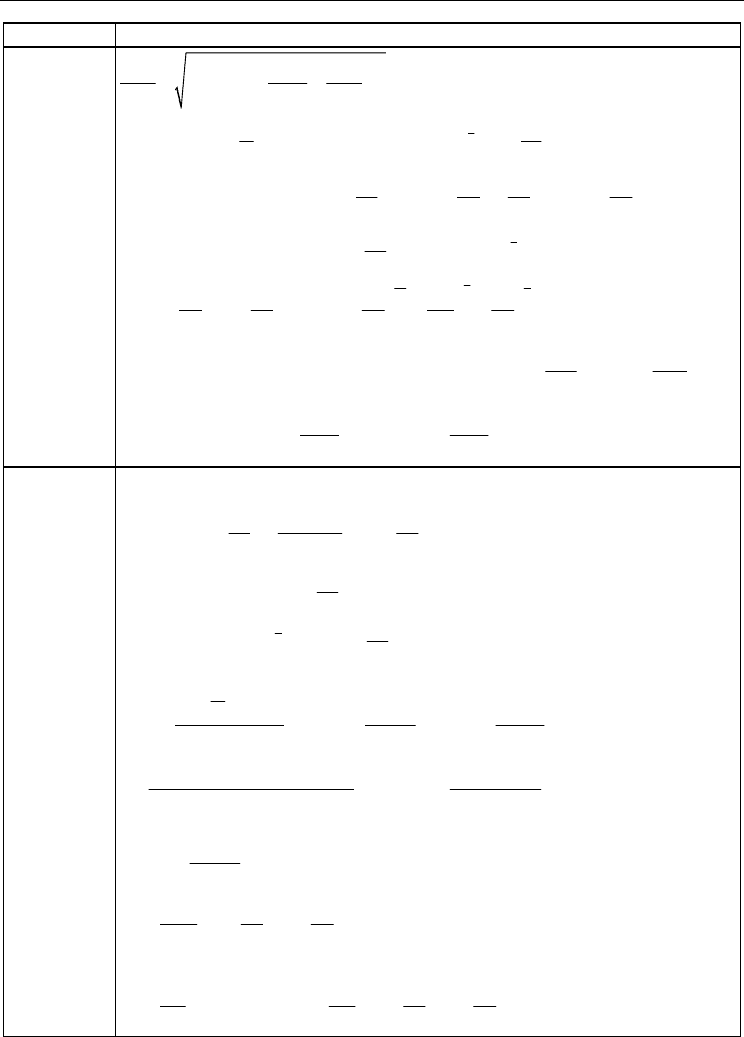
Two Phase Flow, Phase Change and Numerical Modeling
376
Researcher Correlation
Mikielewicz
et al., (2007)
()
2
JM
n
TPB PB
MS
REF REF
h1h
R;
h1Ph
−
=+⋅
+
()
()
()
1
1
3
3
MS CONF
11z
11
R121xN 1xx;
ff
−
−
=+⋅ −⋅⋅ ⋅− +⋅
LAM LAM LAM
LLVL
REF 1 1z
VL V
LAM n 2 ; 4.36 ;f ;f ;
D
λμρλ
=α= ⋅ = ⋅ =
μρ λ
()()
1
0.8
L
3
REF L0 L
1
3
7
0.25
3
2
15
pL
TUR TUR
LV V L
11z
VL LpVV
TUR n 0.76 ; h 0.023 Re Pr ;
D
c
f;f ;
c
λ
==⋅⋅⋅
μρ μ λ
=⋅ =⋅⋅
μρ μ λ
()
()()( )
()
() ()
1.17 0. 6 0. 65
3
L0 M S L0
L
qGd
P2.5310 Re Bo R 1 ;Bo ;Re ;
Gr
−
−
−
⋅
=× ⋅ ⋅ ⋅ − = =
μ⋅
()
()
0.55
0.12
0.5
0.67
nn
PB 10
CRIT CRIT
PP
h55qM lo
g
;
PP
−
−
=⋅ ⋅ ⋅ ⋅−
(17)
Saitoh et al.,
(2007)
SAITOH
TPB REF POOL
hEhSh;=⋅ +⋅
()
0.745
0.581
0.533
Lb G
POOL L
bLSAT L
qd
h 207 Pr ;
dT
λ⋅ ρ
=⋅ ⋅ ⋅ ⋅
λ⋅ ρ
()
()()
L
LAM
REF
4
0.4
L
5
LL
Nu ; LAM
D
h
0.023 Re Pr ; TUR
D
λ
⋅
=
λ
⋅⋅⋅
()
()
() ()
1.05
GL
GL
0.4
GL
G
1
GD GD
X
E1 ;Re ;Re ;
1We
−
⋅⋅
=+ = =
μμ
+
()
()
()
()
b
1.4
4
LG
TP
12
S;d0.510.5;
g
10.4 10 Re
−
⋅σ
==⋅
⋅ρ −ρ
+⋅ ⋅
() ()()() ()
1.25
G
GTPLGL
G
GD
We ; Re Re F ; G G x ; G G 1 x ;
⋅
==⋅=⋅=⋅−
σ⋅ρ
()
()
()
()
()
()
0.1
0.5
0.9
L
GL
G
LG
GL
0.5 0.5 0.5
0.5
0.4
L
LLGL
G
G
GGLG
Re 1000
1x
Xfor;
Re 1000
x
C 0.046 ; C 16 ;
Re 1000
CG
XRe for ;
Re 1000
CG
−
>
−ρμ
=⋅⋅
>
ρμ
==
<
ρμ
=× ×⋅⋅
>
ρμ
(18)
Table 2. Minichannels. Correlation for the heat transfer coefficient in flow boiling
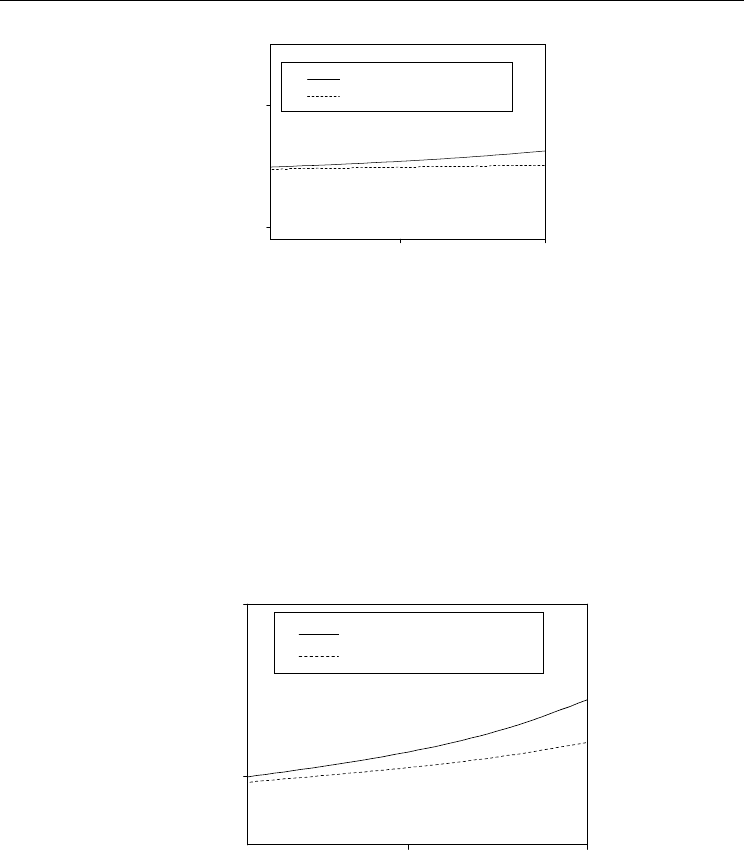
New Variants to Theoretical Investigations of Thermosyphon Loop
377
5x10
2
1x10
3
1x10
3
2x10
3
MIKIELEWICZ (2007)
SAITOH (2007)
h
TPB
[ W / m
2
*K ]
q
H1
[ W / m
2
]
Fig. 9. Minichannels. Heat transfer coefficient in flow boiling
TPB
h as a function of
H1
q
in the
first evaporator. (L=0.2 [m], D=0.002 [m], H=0.07 [m], B=0.03 [m], L
H1
= L
H2
=L
C1
= L
C2
=0.02
[m], L
H1P
= L
H2P
=L
C1P
= L
C2P
=0.005 [m])
3.3 Minichannels. The heat transfer coefficient in condensation
The condensation heat transfer coefficient for minichannels was calculated using the
Mikielewicz formula Eq. (17). The term which describes nucleation process in this formula
was neglected. The heat transfer coefficient for condensation in minichannels was also
calculated using the modified Tang formula (Tang et al., 2000).
5x10
2
1x10
3
1,5x10
3
2,0x10
3
MIKIELEWICZ (2007)
TANG (2000)
h
TPC
[ W / m
2
*K ]
q
C1
[ W / m
2
]
Fig. 10. Minichannels. Heat transfer coefficient
TPC
h as a function of
C1
q
in the first
condenser. (L=0.2 [m], D=0.002 [m], H=0.07 [m], B=0.03 [m], L
H1
= L
H2
=L
C1
= L
C2
=0.02 [m],
L
H1P
= L
H2P
=L
C1P
= L
C2P
=0.005 [m] )
The condensation heat transfer coefficient for minichannels
TPC
h versus heat flux
C1
q
in the
first condenser is presented in Fig. 10.
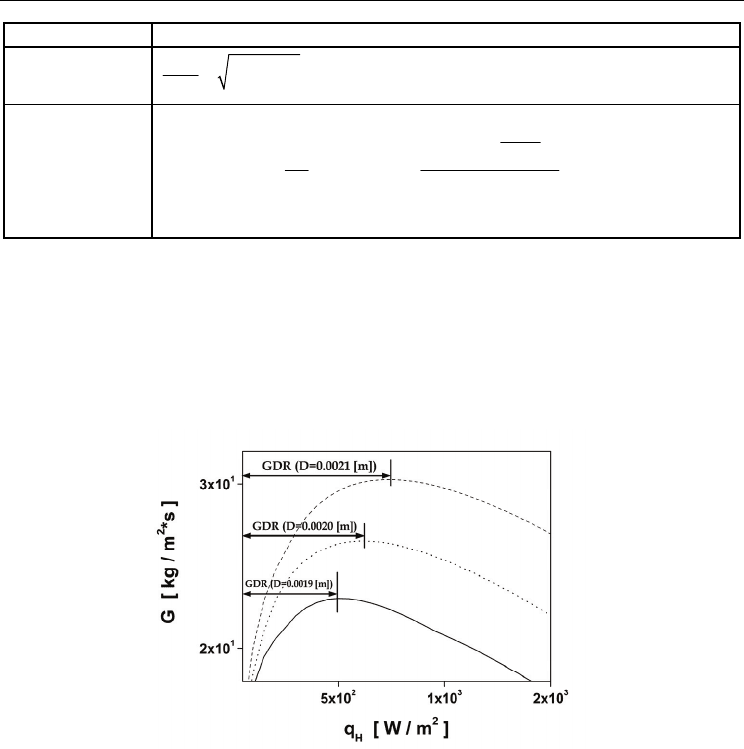
Two Phase Flow, Phase Change and Numerical Modeling
378
Researcher Correlation
Mikielewicz et
al., (2007)
()
JM
n
TPB
MS
REF
h
R
h
−
= ;
(19)
Tang et al.,
(2000)
()
()
()
0.836
SAT
CRIT
TANG
L
TPC
p
xln
p
h Nu 1 4.863 ;
D1x
−⋅
λ
=⋅⋅+⋅
−
(20)
Table 3. Minichannels. Correlation for the condensation heat transfer coefficient
3.4 The effect of geometrical and thermal parameters on the mass flux distributions
The effect of the internal diameter tube D on the mass flux for the steady-state conditions is
presented in Fig. 11. The mass flux rapidly increases with increasing internal diameter tube
D. The GDR (Gravity Dominant Region) decreases with decreasing internal diameter tube
D.
Fig. 11. Mass flux
G
as a function of
H
q
with internal diameter tube D as the parameter
(2H2C). (L=0.2 [m], H=0.07 [m], B=0.03 [m], L
H1
= L
H2
=L
C1
= L
C2
=0.02 [m],
L
H1P
= L
H2P
=L
C1P
= L
C2P
=0.005 [m] )
The effect of length of the heated section
L
H2
on the mass flux is demonstrated in Fig. 13. If
the length of horizontal section B is constant, the mass flux increases with increasing length
of vertical section H due to the increasing gravitational pressure drop. The increase in length
of the vertical section H induces an increase in both the gravitational and frictional pressure
drop. However, the gravitational pressure drop grows more in comparison to frictional
pressure drop.
The effect of length of the heated section
L
H2
on the mass flux is demonstrated in Fig. 12. The
mass flux increases with increasing length of the heated section
L
H2
in gravity dominant
region (GDR) but in friction dominant region (FDR) the mass flux decreases with increasing
length of the heated section
L
H2
.
